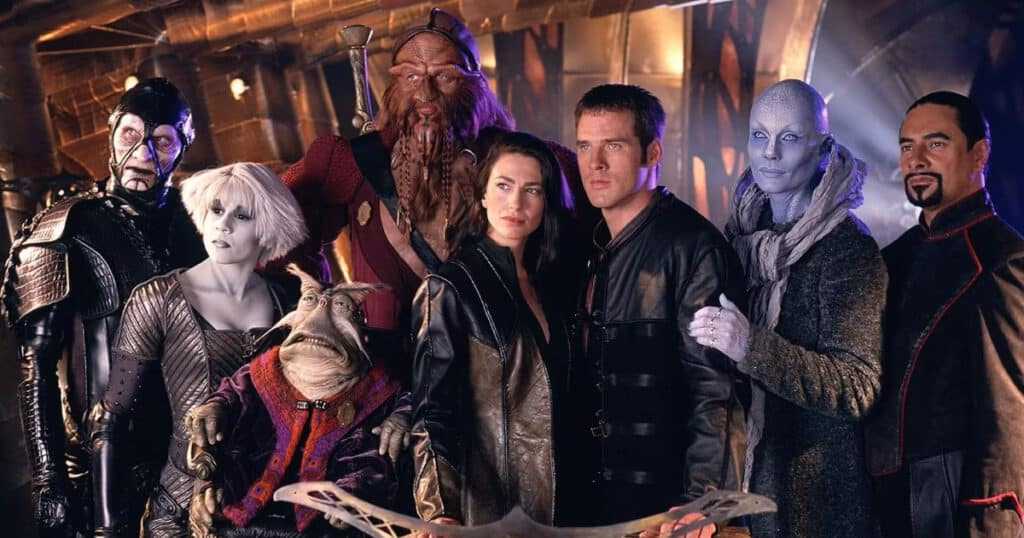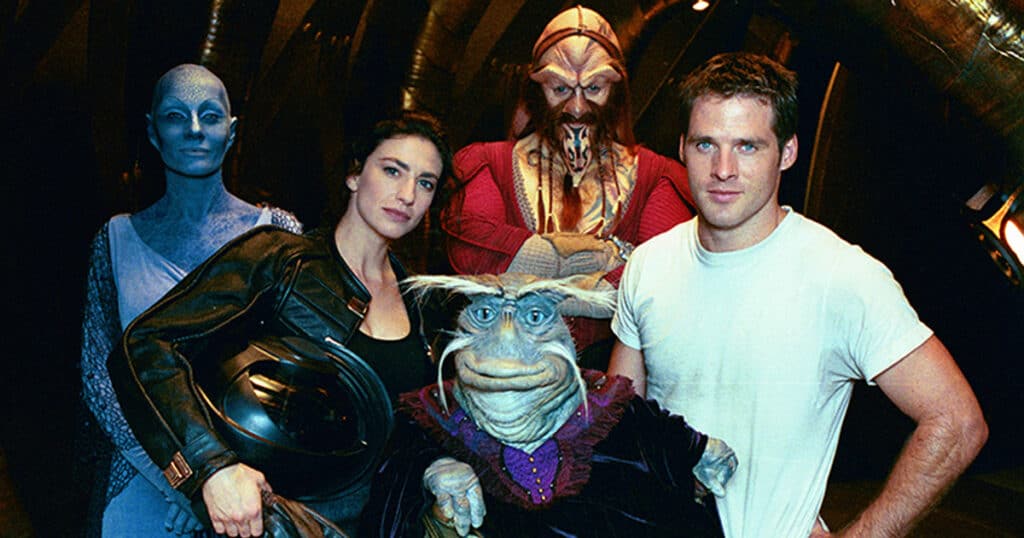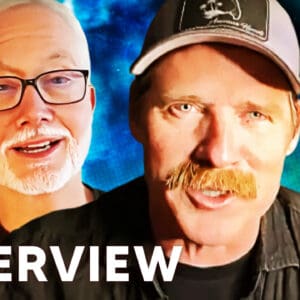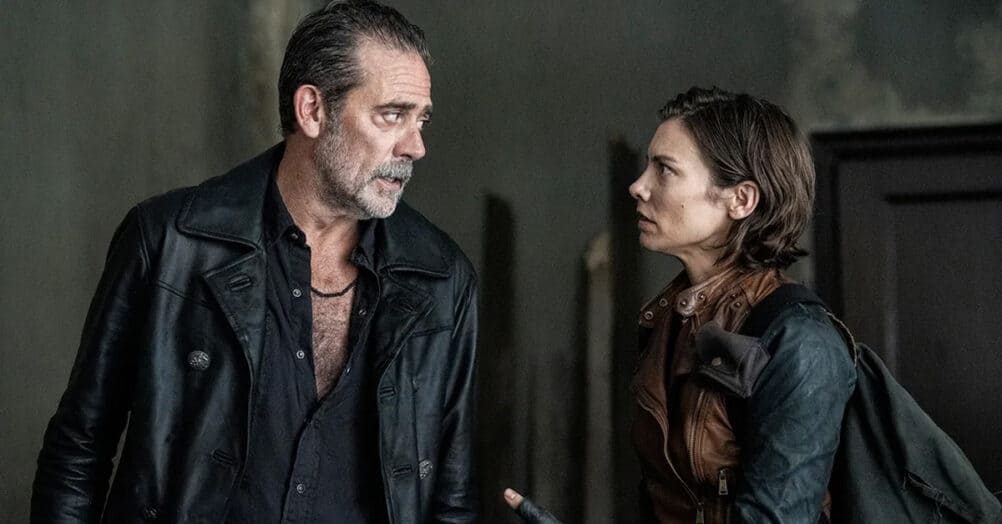
The name Henson is one that the world recognizes when it comes to creating magic. Brian Henson carries on what his father started by doing just that. Over the years, The Creature Shop (which we recently visited) has designed and brought to life some of the most beautiful and ingenious creations that audiences have ever seen.
Brian Henson grew up making worlds like those in Dark Crystal, Labyrinth, and more, and he would be one of the keys in creating the boundary-breaking now iconic series Farscape 25 years ago. Since then, The Creature Shop has gone on to return to the world of The Dark Crystal with The Dark Crystal: Age of Resistance, bringing to life a slightly more sinister batch of creatures with The Curious Creations of Christine McConnell and some VERY sinister ones with Five Nights at Freddy’s.
But Farscape took things to another level for Henson and his crew and remains a strange and beautiful jewel in the crown of the shop’s legacy.
I had the honour and pleasure to speak with Brian Henson about what went into the creation of Farscape as it hits the quarter-century mark, as well as some of the other works that helped lead to taking on such a project.
JoBlo: I’m just overwhelmed that it’s 25 years because that’s basically half of my life that this show has been part of the fandom. How did you wrap your arms around the scope of it? Because it’s so big.
BH: Well, it didn’t come to us. We generated it internally. And the original idea was try to capture a little bit of the character insanity from, like, the Star Wars bar. And then that was sort of a jumping-off point, but do it in a Hensony kind of way. And then as we tried to work out sort of what the formula was, it was Rockne’s idea to put a human from our time as the main point of view, because otherwise, weird isn’t weird, you know, shocking and unexpected may not be shocking and unexpected to the characters. And I think that was genius. So that you always have John Crichton there going, oh, my God, what are you? Whereas everybody else you know, if he wasn’t there, you maybe wouldn’t be able to do that. You wouldn’t be able to enjoy this very weird, unexpected universe that we had created. So then, in terms of how will we wrap our heads around the size of it? Well, part of it was we needed to produce very efficiently because this would be the first TV series that the Sci-Fi channel in America was going to license. And so they couldn’t afford what a US license fee for Star Trek was or anything like that.
So we had to work very efficiently. And that meant leaning very hard on the character relationships. Let’s say you’re in a battle sequence. You want to make sure that the most interesting part about the battle sequence is Aeryn and John fighting with each other. Having an argument while shooting. So that you don’t really have to show the battle. You know, that sort of thing. So it’s like we needed to put much more emphasis on the character dynamic. As opposed to the bigger stories that they were playing so that we could produce more efficiently. But it was one of those where we basically had to make 23 episodes or 22. We had to make 22 episodes for it to make any sense at all, budget wise. Because just to make that first one is like. That’s like the budget of a whole movie. Because you have to make all the creatures. You have to make all the sets. So the way we set off doing it was we knew we were going to basically make 22 episodes. Or rather, Sci-Fi had a big penalty they would have to pay if they decided to cancel it after 13.
So it was technically a 13 pickup. But then they would add the other nine to avoid a penalty. That’s the way we jumped into it. And it was years. We were pitching for five years, Rockne and I. And then eventually David Kemper came into the mix. But, yeah, we’d been sculpting maquettes and figuring out what everything looked like. It was a big lift to convince anyone to license it. Also because it was totally so dramatically different. Because we wanted something that was totally, completely different from Star Trek which was the dominant science fiction on television at the time. We wanted something that was much more primal and emotional and wilder and more unexpected and creepier at times. We kind of wanted to amp up all of that. And do something quite special and quite different than what had been on television up to then.
JoBlo: Well, one thing that kind of leading into that, and I’d asked Rockne about this because I’d spoken to him a little while ago, was he told me the writing aspect of this. But I’m just curious for you, because it’s more physical in your world. The design that goes into these creatures. Do you do any sort of looking into the biology aspect when designing these creatures? How deep do you go when designing them?
BH: Everyone, every different one is different. I can tell you the ones that were on the ship that being Rigel, Zhaan, D’argo, Pilot so of those four, we did enormous, enormous amounts of backstory and back study and biology study. Lots and lots of work on Zhaan and what Zhaan looks like, because she’s actually a plant. So what does she look like when she blooms? We did so much work, basically, on all of them. And what’s the backstory of their planets and their cultures? Because all of that can inform, obviously, as you’re trying to make multiple episodes. Now on the episode specific creatures, as television often is true, it’d be like, look, this creature has one scene to do. What can you do that’s just really cool that you can make quickly? It’s only got to do one scene. And I call that the Creature Revolving Door. And just like on the Muppet Show, this is how we discovered that penguins were great Muppets. Was we made one for one little thing, or this is how we figured out the cows are really funny Muppets, because we made one cow and went, oh, my God, this is so funny.
So sometimes we would make a creature very quickly to do one episode and then be really blown away and think, oh, this is a really fun creature. We didn’t expect this to be that good.
JoBlo: Well, and kind of going along with that. And again, as I’ve stated, growing up with the work that you and your family have done, it felt neat to have these characters who became friends to you. And within Farscape, I think that was really personified, where you have these people that become a family of oddballs. And I just was curious about the emotional aspects of that. You make these inanimate objects come to life in these shows and the things that you do. Can you talk about imbuing them with life and emotion and how that works in Farscape?
BH: Well, I think it’s always hard for writers and filmmakers to invest enough depth in the realizing of a creature, and you’ll see that all the time. But this is a lesson we’ve learned from puppetry over the years. You have to treat them with the same amount of respect that you would a character that’s going to be portrayed by an actor. And there’s so much that just automatically comes when you’re working with actors. Their accent tells you an awful lot. The way they dress tells you an awful lot. There’s an awful lot of information that your audience is going to get from that character just automatically. And the filmmakers often, and the writers often don’t, they take that for granted. So when you have a creature, you kind of have to make sure you’ve done the same amount of work, even if it’s not obvious to the audience, even if it all just looks alien to them. You can quickly get a sense of that real depth of personality, and then you can make it funny, and then you can do all that work and then have it be Rigel and have him be a grumpy one liner, rude, self-centered, and a jerk.
But you do have the full sense of him as a deep and real character, and I think that’s what’s needed in order to be able to emotionally invest in them. And I think this is what my dad proved over and over, that it doesn’t matter how realistic the character is physically. It matters how realistic the character is personality-wise. And attitudinally, do you believe it? Like Kermit The Frog? Everyone believes Kermit The Frog. They believe him as a living, emotional being, even though he’s just made of felt and ping-pong balls. Perhaps that’s where we have a little bit of an edge, because most people who make creatures make creatures that eat things, eat people or jump out of things. That’s why creatures are more in the horror genre than where we go. Whereas what we like to do is create characters, real characters that you believe their personality, but that has to be reflected in the writing and directing well.

JoBlo: And also kind of bouncing off of that. You were part of one of my favorite TV series of all time, The Storyteller. And I love thinking about how shows like Farscape are kind of like the new mythology, and you’re creating those old tales, these are our old tales coming into the future. And I was just curious what your thought about that. You’ve created this mythology within this series.
BH: Well, yeah, it’s universe-creating. That’s the fun. When you’re creating a universe, can you make it believable? Can you make it a living, believable universe that people want to be part of? And with science fiction, with the great science fiction writers as a kid growing up, it was like, oh, my God, every one of those universes, the good ones, it was like, oh, I so believe this universe. And I get how the politics are bouncing around. So that is a lot of fun. But definitely creating worlds is something that our company, starting with my dad, of course, has always been doing, and then sort of amped it up with Dark Crystal into a more realistic, richer visual realization of both characters and environments. And that went on to Labyrinth, that went on to Storyteller. And Storyteller was fantastic because each one of those episodes, there’s nine episodes. Each one is a feature film. Each one has an incredible epic story with great characters and creatures. And so we had a lot of fun making that because it was like making nine mini features back-to-back.
JoBlo: Hans My Hedgehog is still to this day, like, one of my favorites. I thought that was so beautiful.
BH: Yeah, that’s a great one.
JoBlo: I’m going to gush a little bit about that because I really love it.
BH: It’s such a wonderful series, and it really pulled us, the Creature Shop in London. That’s really who I was working with exclusively at that time. It really pulled us together and focused us on how good we could realize something and how quickly it helped us really better our game, if that’s the right term. And then we went basically from Storyteller to Ninja Turtles. Very ambitious project. Not enough money or time to really do it the way we wanted to. But, boy, we did some ambitious stuff in that then doing Dinosaurs, where we were able to relax a little bit and do it a little bit more properly. But it was comedy, it was a sitcom. So it was really fun to sort of take what we were learning there about world-building and character-building, but then take it into a much more dramatic genre and into science fiction, which is just a lot sharper than fantasy. Fantasy can be very exciting and dangerous, but science fiction, almost automatically is always very exciting and dangerous.
JoBlo: Exactly. Well, sir, thank you so much again for taking the time. It was amazing to get to talk to you about this and thank you again for all the work. I mean, you helped create worlds, as you said, for a lot of us. So thank you.
BH: Well, you’re welcome. It’s lovely to talk to you, Jessica.
If you want to revisit Farscape yourself, Shout TV has you covered! In celebration of the anniversary, Shout! TV will be introducing new commercial break interstitials to Farscape TV, including trivia, production memories, and more featuring Ben Browder and Gigi Edgley. Farscape is available to stream at Farscape.TV and through the Shout! TV app.

















Follow the JOBLO MOVIE NETWORK
Follow us on YOUTUBE
Follow ARROW IN THE HEAD
Follow AITH on YOUTUBE